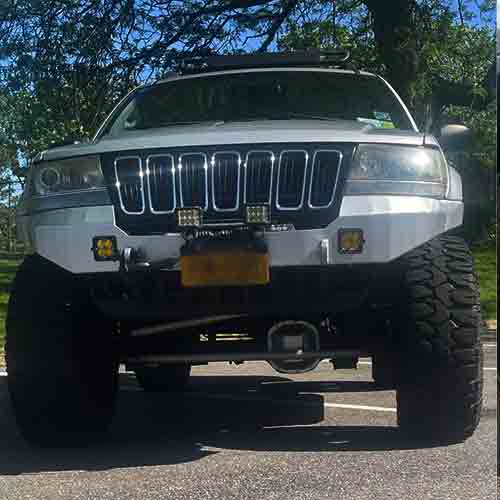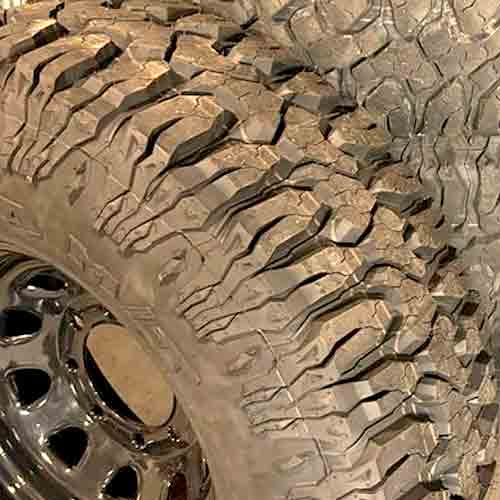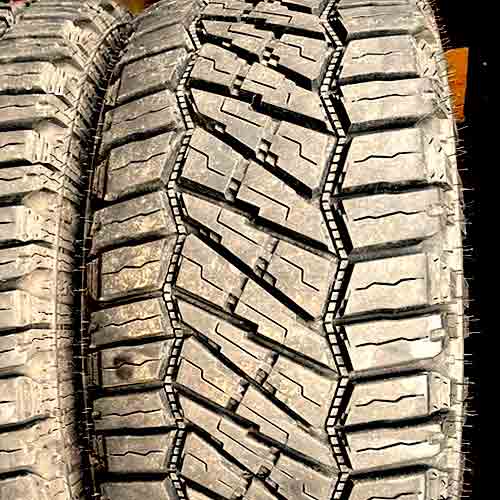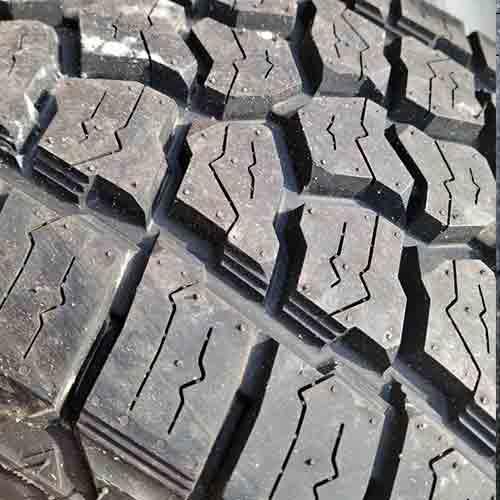All of these Milestar Patagonia tires give you a very suitable and reliable options for your light truck and full sized SUV as they offer a great balance between traction and comfort. Although overall, the mud-terrain variant did better off-road, compared to rugged-terrain, and all-terrain, (to nobody’s surprise), there are still some interesting findings about all of them. Let’s check them out!

Sizes Facts
Milestar Patagonia AT/R comes in 15 to 20 inches rims with following specs.
- Speed ratings: T and Q only.
- Load ratings: XL, C to E.
- Weight range: 33 to 67 lbs.
- Tread depth: 13 to 16/32″ (Most sizes have 16/32″)
- UTQG: 540 A B.
- Winter ratings: Only M+S.
- Warranty: 50k miles.
The Milestar Patagonia XT on the other side, comes with 15 to 22 inches with following specs.
- Speed ratings: Q, S and T.
- Load ratings: C to F.
- Weight range: 50 to 86 lbs.
- Tread depth: 15 to 19/32″.
- Ratings: M+S and 3PMSF.
- Warranty: 40k mile on all.
And lastly, the Milestar Patagonia MT provides you with 15 to 22 inches, with following.
- Speed ratings: Q on all.
- Load ratings: C to F.
- Weight range: 50 to 88 lbs
- Tread depth: 18 and 19/32″.
- Ratings: No 3PSMF.
- Warranty: None.
(These also include 3 “black labelled” sizes as well, and these include, 37X12.50R17LT, 38X13.50R17LT and 40X13.50R17).
Tread Differences
Let me start here with the Milestar Patagonia MT.

In the middle, the tire only makes a single rib, though it’s very effective.
That’s because this rib provides both lateral and directional grip (where mostly they only offer directional).
It contains U shaped middle lugs which are compacted up, having very small gaps in between them, this allows for a constant contact with the road as the tire rolls, providing the needed grip.
And at the same time, with their U shaped lugs, they get to wrap around the shoulder blocks, providing them in lateral stability.
Same goes for shoulders, which are joined up on sidewalls, providing stability, despite having a lot of tread depth.
And at the same time with multiple biters in the form of notches and serrated edges, you get off-road traction.
Moreover, both the central and middle lugs have full depth interlocking sipes which aid in wet traction.
Now lets move on towards the rugged terrain tire, the Milestar Patagonia XT.

The central part of the tread has sharp triangular shaped blocks arranged in a horizontal alignment and compared to shoulder lugs, they are slightly sharper and bigger.
And so they get to be more biting with their edges and chamfered sides, though they also have stepped notches in the middle as well providing additional off-road bite.
Though with closed up design, they ensure their on-road stability is also not compromised by a lot, that’s why they make narrower lateral grooves compared to outer circumferential channels.
These outer vertical zigzag tread voids are also engraved with small biters throughout which act as stone ejectors and break down the particles so that they can easily leave out the tire as quickly as possible.
Moving towards the shoulders, these lugs are smaller, yet they have similar biters, and their outer edges are staggered.
Though the tire could use some sidewall lugs, as in comparison, they are not very biting (when you lower the air pressure down, off road).
Lastly the Patagonia ATR stands out with its less-aggressive sides.

Unlike its variants, it features less no lugs on the sidewalls, so it can’t give you the additional crawling traction when the tire is aired down to lower PSI values.
The lateral voids of shoulders contain stone ejectors (though not as bold as other variants), and these lugs are connected to each other with the help of ridges.
The lugs features sharp “snow vices” or teethed biters (also located on the outer central ribs), and they also feature more siping, though they are rectilinear.
Moving towards the tire’s middle…
The structure is largely unchanged, with four vertical channels; the outer ones are broader and feature snow vices.
Every rib houses block pairs connected by underlying rubber, reinforcing the tire’s foundation and offering improved traction and grip.
Moreover, worth reminding, these blocks also incorporate 3D full-depth sipes with interlock technology.
Dry Capability
A comprehensive appraisal of an all-terrain tire’s dry performance necessitates a detailed exploration of two primary attributes: directional grip and the tire’s prowess when it comes to cornering. Each one of these has its own intricacies that we will now delve into for a better understanding.
Dry Grip
In the world of tires, a more voided or “balder” tire usually encounters more challenges in terms of maintaining grip.
This is why the more aggressively designed mud-terrain Milestar Patagonia MT, with its highly voided design, finds itself falling short in this particular arena.
In contrast, the Milestar Patagonia ATR, fashioned specifically for diverse all-terrain use, proudly exhibits a wider central running rib.
This component is supported by sturdy, reinforced foundations, allowing not only for an greater contact patch for superior road interaction, but also for enhanced directional stability.
Interestingly, the Milestar Patagonia XT, which situates itself somewhere between the mud-terrain MT and the all-terrain ATR, only slightly lacks to ATR in terms of dry grip performance.
To put it into perspective, its braking distance, which is BTW, a direct measure of directional grip, averages only about two feet longer than that of the ATR.
Handling
The overall handling of a tire hinges on a delicate balance between two critical elements: the flexibility of the tread and the design of the shoulder lugs.
And from this vantage point, the Milestar Patagonia ATR makes a compelling case for itself, and here’s why.
The tire tread lugs feature solid foundational supports underneath. Basically all its shoulder lugs sit on a secondary rubber layer.
This support the blocks when under stress, such as during sudden braking or sharp turns (not allowing them to bend a lot).
This results in quicker steering response time, contributing to the ATR’s outstanding handling characteristics.
On the other side, the Milestar Patagonia MT, with its more flexible compound and lesser block support, displays a greater tendency towards oversteering and understeering.
This results in slower response times, thereby leaving it lagging behind the other two variants.
Additionally, the M/T’s lugs are set wider apart, which inherently reduces the tire’s contact with the ground, and consequently slows down its handling times.
Lastly the Milestar Patagonia XT, despite showcasing well-supported lugs and connectors between the blocks akin to the ATR, falls short, still, mainly because of its great weight (which is only a few pounds short of M/T).
But why is that?
Well, as the tire corners, the weight shifts towards shoulders, and lugs there flex and bend more, causing a delayed time and susceptibility of understeering and oversteering, which then delay steering response, and which then limits overall handling efficacy.
Road Noise
Noise originates from a multitude of sources, but it is primarily generated by the interaction of air and tire treads, resulting in three distinct types of sound waves.
One type, gets produced due to the inflow of air particles which create whistling sound.
The second is also form air particles though its created when they hit the walls (the impact makes noise, I mean).
Lastly, as noise gets generated, it bounces off the walls of the tread, creating in-groove resonance.
Now, because of its balder structure, the Milestar Patagonia MT tends to produce most of these noise types.
In contrast, the Milestar Patagonia XT and ATR, with their densely packed lugs, limit excessive air inflow. Since most of the air enters through shoulders, these tires have blockers there, restricting air to move in.
Moreover, their comparatively stiffer rubber also hampers the generation of groove resonance (MT creates more echoing in comparison).
And yes, one more thing, both of these tires also incorporate variable pitch technology, a design innovation that varies the tread pattern.
As a result, air particles strike at different angles on various lug geometries, leading to the creation of distinct sound waves that eventually cancel each other out.
Snow and Ice Traction
The all-season capabilities of off-road tires have been continuously improving. So now most of these tires provide reliable traction during summer, while also proving to be impressive on snowy terrains.
This improvement is exemplified by many of these tires, including the Milestar XT, which have received the 3 peak mountain snowflake rating (unlike the other two boys).
So given this, it is not a surprise that the Milestar XT outperforms its counterparts in almost many snowy conditions. (BTW, this conclusion was drawn after testing all three tires across diverse snow conditions, including ice and packed snow).
The Milestar XT is designed with numerous tiny ‘biters’ capable of adhering to snow particles, enabling snow-to-snow contact. This interaction is particularly beneficial as snow adheres more readily to other snow rather than to rubber.
Moving to other tire, the Milestar Patagonia ATR secures the second spot here. The tire although does not show commendable performance on ice, its on-road snow traction is only slightly behind the XT variant.
And lastly, the Milestar Patagonia MT, due to its larger void structure, does not retain snow as effectively as the others. Despite this, it serves as an excellent snow scooper, delivering commendable performance on deeper terrains, throwing mud backwards, and generating forward momentum, as a result.
Durability
The demands of rough terrains and sharp objects in off-road driving call for the durability of off-road tires. To meet this requirement, the design of almost all off-road tires includes cut-resistant rubber, though still the major durability comes form internal construction.
And to nobody’s surprise here the Milestar Patagonia MT takes the lead with its rugged 3-ply polyester cover with 2 steel belts on top reinforced with a single cap ply of nylon, though the amazing thing is the tire is not that heavier, compared to other M/Ts.
The Patagonia XT also feature 3 ply sidewalls, but its still not that durable as its rubber thickness is lower, and is rubber is also not that resistant to cuts too.
The least durable here is the Milestar Patagonia ATR, with it’s 2 ply sidewalls.
Rugged-Terrain Traction
It’s obvious here which tire would perform better off-road. Yet, to quench my curiosity, I subjected all these contenders to various terrains. See them all below.
Muddy Tracks
Mud traction relies heavily on two things: quick self-cleaning and sharp scooping skills. Predictably, mud terrain tires outclass their all-terrain or rugged terrain siblings in this messy bout.
The Milestar Patagonia MT, flaunting a extremely voided structure, excels in mud with its superior self cleaning capabilties.
Moreover, its staggered shoulder lugs with thicker (of all tires) mud scoops, effectively paddle through the terrain, throwing back thick clay, generating forward moving inertia.
On the flip side, the Milestar Patagonia XT and ATR, though tightly packed tread voids lack here. And out of these two, the ATR is lacking the most as its even missing with proper mud scoops and sidewall lugs.
On Sand
In sandy situations, tires need to master the art of both floating and paddling.
And here once again, the Milestar Patagonia MT shines, topping the leader board. The tire despite being heavier of all variants, still does better thanks to its sidewall lugs that broaden the contact patch with the sand.
The Milestar Patagonia XT secures second place, courtesy of its excellent sidewall biters, and traction scoops, while the ATR comes in last, with its sharper outer edges, and missing lugs on sidewalls.
So it’s more susceptible to digging on this soft terrain.
Rocky Trails
Conquering rocky terrains demands not just grip, but also multi-angled traction and tough-as-nails sidewalls (puncture central, as experience testifies).
A tire with multiple “grip angles” can better ascend without risking overturning due to inadequate lateral traction.
And this is where robust sidewalls step in. They offer extra grip, especially with reduced air pressure.
And so these factors explain why the Milestar Patagonia MT offers superior traction, off all the variants.
Besides offering bigger groove mouth which grip in much better, it also outpaces the Milestar Patagonia XT especially in case of toughness, despite both sporting 3-ply sidewalls.
(Basically MT’s thicker sidewall lugs add a much superior layer of protection).
Here the most lacking of course is the Milestar Patagonia ATR, which is missing with features such as sidewall lugs, a wide enough groove mouth, and having a soft tread compound that helps lugs clutch the rocky surface.
Dirt and Gravel
Resisting cuts is just half the story for off-road tires on gravely tracks, I mean they also need to excel at self-cleaning.
So having said that, the Milestar Patagonia MT, equipped with bold stone ejectors, steals the spotlight, as its balder structure dont’ allow any debris to settle in, and the ones that try to are ejected right away with bold stone ejectors.
On the contrary, the Milestar Patagonia ATR, with numerous sipes and notches, falls behind as these crevices can trap stones, damaging the tread and limiting overall performance.
The Milestar Patagonia XT also under-performs here, due to missing stone ejectors and its overly compact shoulder and central area for a rugged terrain tire.
(Rugged terrains tires, are actually hybrid, having mud terrain tires like shoulders, though its not really the case with Milestar Patagonia XT).
Fuel Consumption and Tread Longevity
A tire’s weight and tread stickiness significantly influence a vehicle’s fuel consumption.
In this light, it’s no wonder that the Milestar Patagonia ATR yields superior fuel mileage. Its design features a lighter structure, more stable lugs, and smaller spaces in between.
The benefits of a lightweight tire are clear, it takes less energy for its movement. and with stable supports, and smaller tread gaps, the lug bending is limited. So less energy is used up/wasted in flexing and more is channeled into tire rolling.
In contrast, the Milestar Patagonia MT and XT are very lacking here, mostly because of their weight.
These heavyweights showcase more rolling inertia and their lugs are more susceptible to bending, consequently burning more fuel.
Their increased weight also means that their lugs press harder against the road. This combined with a softer tread compound results in faster wear as well.
So it makes sense why in terms of tread life, the Milestar Patagonia MT falls behind, offering no warranty.
Whereas, the Milestar Patagonia XT provides a 40,000-mile warranty, while the Milestar Patagonia ATR impresses with a 50,000-mile warranty on all sizes.
To Sum Up
The Milestar Patagonia ATR excels in on-road grip, handling, and steering response, which is expected, given its less aggressive nature.
Moreover, other on-road aspects, such as fuel efficiency, comfort, and tread life, also favor the ATR.
Though, interestingly, the Milestar Patagonia XT outperforms all its variants, in snow traction, showing much better handling effectiveness compared to other two.
And off-road, however, the true titan, the Milestar Patagonia MT, outshines the others across key terrains: mud, sand, rocks, and even gravely roads.
Though on gravel, it was somewhat peculiar to observe the Milestar Patagonia XT’s under-performance even compared to ATR.